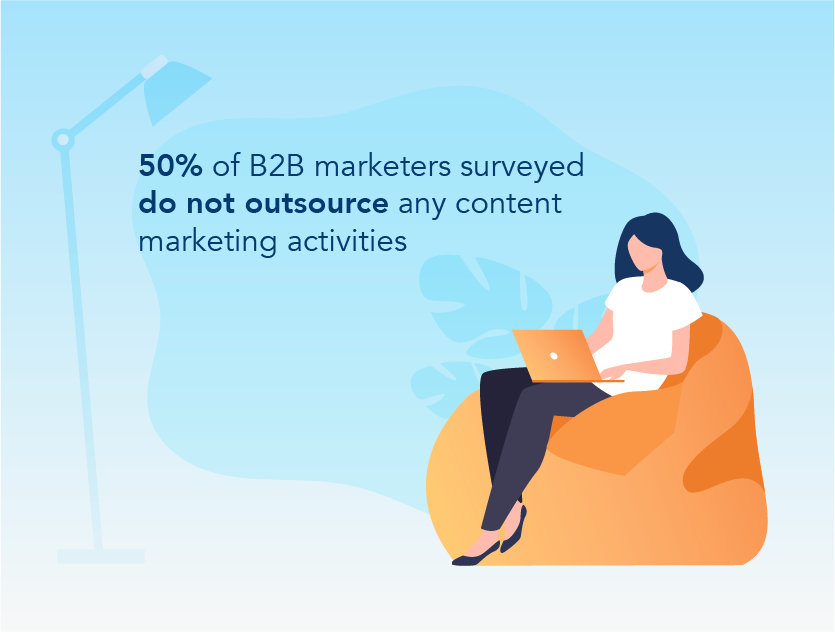

The Pros and Cons of DIY Content Marketing

Should you try content marketing on your own? Here are some tips and tricks.
If you’re reading this, you’re probably already familiar with content marketing and how it can help you raise brand awareness.
Content marketing is cost-effective in the long run as good content marketing helps you build a strong relationship with your customers and delivers a high ROI.
But what if you lack the funds needed to jumpstart your content marketing efforts via outsourcing? As it turns out, taking the job in-house isn’t too hard either.
What is DIY content marketing?
Source: Content Marketing Institute
It’s pretty self explanatory — it’s just content marketing, but conducted by your own company instead of engaging an agency with content marketing expertise to help you do the work.
You already know the benefits of content marketing: it is an effective way to drive traffic to your website, build brand awareness, and increases client retention. By providing reliable and useful content, you can increase your chances of converting potential clients into actual sales.
It is also a way to show off your expertise by positioning your company as a thought leader in your field, which then helps your brand gain credibility as a trustworthy source. The sheer amount of content you produce also helps improve your website’s search visibility by boosting SEO.
But on top of reaping just the benefits of content marketing, you get to reap the benefits of doing it yourself too.
Benefits of DIY content marketing
1. Cost savings
As with everything else, in-house production is always going to save you money. Hiring external agencies will cost extra, especially for the full package — from conceptualisation to content creation, and maybe even data analytics to see how well the content performs.
But with that being said, it’s no doubt that content agencies do know what they’re doing, and they do it well. In essence, you’re paying for their professional skills and services, which helps if you lack the ability to create the kind of content that you envision for your brand.
2. Niche content scope
Sometimes, it might actually be easier for your company to do its own content marketing. It might seem counterintuitive, but hear us out.
Your team has the most knowledge about your own company in terms of goals, objectives and procedures. Moreover, everyone in the company has insider knowledge and experience within your own industry that others might not be privy to, especially if you are working in a niche sector.
Taking into account all the time you might have to spend explaining your industry and your work to a third-party provider, as well as the time you need to spend consulting on each piece of content produced, it really might just be easier — and more efficient — to do it yourself.
3. Have a complete overview
Of course, doing it yourself gives you complete control over the entire process. Essentially, you’re in charge of everything; from content types to distribution channels to amplification methods, you get to call all the shots.
The chain of command is shorter if you get to bypass the external agency, and that means any changes in strategy and content can be made more quickly.
Moreover, you have the clearest idea of what you want for your brand’s content marketing. Having a complete overview of the full process and being involved in every step of production also means the final product will be in line with what you had envisioned.
Cons of DIY content marketing
1. It can be time-consuming
Like we’ve mentioned before, content marketing is for the long-haul. Consistency is key, not just in quantity but also in quality, if you want to truly succeed.
That means you need to be producing good content on a regular basis. A lot of research work and editing goes into writing just one blog, and we’re not going to lie to you: it takes time. And time spent on crafting content means time away from your actual job tasks.
Bottom line? It’s more work.
2. You might end up incurring additional costs

Source: Content Marketing Institute
If you want to avoid taking on the additional workload yourself, you might end up needing to hire someone new to do it in-house.
Or perhaps, you could just do some internal shuffling and appoint one of your existing employees to be the new content marketing in-charge. That is, provided someone in the company has the necessary skills and knowledge to carry out the job competently. If there isn’t one though, then you might need to incur additional costs to invest in training your staff and obtaining resources.
Whichever route you do down, do ensure that the expenses from in-house content marketing are not actually higher than your returns, or higher than engaging an external professional content agency.
3. Content marketing is a specialised field
Content marketing is considered a specialised field, and in this age of the internet, you need to be careful about how you execute your campaigns.
If not executed well, DIY content marketing might have no results to show for all your efforts. Even worse, a wrong move could completely jeopardise your entire brand reputation.
Things like tone, sensitivity of topic chosen, language and even imagery used need to be carefully fact-checked and vigorously edited before it goes live. You don’t want to accidentally offend someone!
What’s in a content marketing strategy?
Source: Content Marketing Institute
So you’ve laid out all your cards, carefully considered your position, and you’ve decided to go ahead with DIY content marketing. Where do you start?
It’s time to lay the groundwork by formulating your content strategy:
1. Define your goals and objectives
Do you want to drive traffic to your website? What kind of content do you want to produce? What is the purpose of your content?
When we say goals, we mean specific goals. Maybe you want to have a 10% increase in traffic to your site by the end of the year, or hit 50 new subscribers to your newsletter in six months.
If you can establish what your goals are before you begin planning your content calendar, you’ll have an easier time determining what kind of content you should put out and how.
2. Identify your audience personas
For your plan to be successful, you need to clearly define your brand’s target audience. What are their demographics and needs? By knowing your target audience, you can produce more relevant content that they’ll want to read and be more likely to convert on.
Next, you need to map out the buyer’s journey. Where are the gaps you want to plug with your content and how will your content help move them further down along the funnel?
It’s also here where you decide on the tone and style for consistency.
3. Have a content calendar
A content calendar is quite literally the backbone of your strategy. As with everything else that needs to be executed, planning is key.
By creating a schedule, it is easier for you to keep up with all the content you need to produce either on a weekly basis or even on a daily basis.
Having that monthly overview also means you can take note of key industry dates/events, company events, holidays, and plan your topics around them.
4. Develop your content
Next comes finding out the topics and the types of content marketing that will appeal to your target audience. If you’re stuck, check out this Click2View guide on the Top 7 Content Types to try in 2020.
It’s also time to do some market research on your competitors to scout the types of content they produce, and what keywords they use to guide their content.
Your aim should be to analyse and learn from them what it is that they do well, but also to set your brand apart. Is there a topic or area that they don’t cover? Or a particular topic that you feel you know better? It’s time for you and your branded content to swoop in and plug that gap!
5. Distribute your content
Decide on the content marketing channels to use based on your target audience. Is your content going to be hosted on a third party platform, or is it going live on your own website?
After the initial posting, will they be amplified and cross promoted on other social media platforms? If you are putting up a blog hosted on your own webpage, make it easy for your audience to share your content by placing social sharing buttons in strategic locations all over your own site.
Do note that some social networking platforms are used more by certain demographics, or fit a particular type of content more so than others. For example, Pinterest is quite popular for infographics, you have YouTube for video, while LinkedIn is geared towards professional networking.
Check out our guide to digital amplification for more tips on distributing and promoting your content.
6. Keep track of the analytics
To know if you’re doing things right, you need to track the performance of your content. How many people are visiting your site now that you’ve started posting more regularly? How many people like your social media posts? What’s the bounce rate for your landing page?
It is only with data analytics that you can figure out what works, and what doesn’t, for your business. Once you’ve figured out the flaws, it’s time to iron out the kinks and adjust your strategy when necessary.
Tools and resources for DIY content marketing
For someone new to the content marketing scene, it can be completely intimidating to take the job in house and do it yourself. Luckily, there are a few powerful tools readily available on the web to help you better manage your workflow.
Search Engine Optimisation (SEO) tools
The best part about using these tools is that you save all the time and effort spent on doing a manual SEO audit on your site.
Apart from telling you how your own site is doing, SEO tools also help you gain invaluable insights into what your competitors are doing when it comes to their SEO efforts.
Google Ads Keyword Planner helps you identify the most relevant keywords that your brand should target in your online advertising campaigns.
If you’re looking for something that is a little bit more all-encompassing, try SEMrush — a popular one-stop platform that you can use to track the keyword strategy used by your competition, look for backlinking opportunities and plenty more.
Content research tools
In order to provide relevant content that your target audience wants to know, you need to know what’s currently trending.
It can take up so much time doing a manual search audit, or maybe you’re just not that in the loop. If you can’t decide the kind of content you need to put out, you can try your hand at these content research tools to generate ideas.
Buzzsumo allows any user to find out what content is popular by topic on any website, while Hubspot’s Blog Topic Generator allows you to input a noun and have a list of related blog post ideas ready within seconds for your perusal.
If language is not your strongest suit, there are a wealth of free writing tools available on the web that can help you edit and improve your writing so it is easy to read and understand.
Grammarly is a popular writing tool used to correct any grammar and spelling mistakes, while Hemingway Editor can help highlight lengthy sentences, common errors, and even provide synonym suggestions for difficult words.
Writing tools
Source: Content Marketing Institute
Without proper distribution, there’s no point creating that much content. Who’s going to see it?
A common method of content outreach and distribution takes place via email marketing, where you can reach your target audience right where they visit everyday — their inbox.
Mailchimp is a platform that helps you automate your email marketing efforts: manage mailing lists, create newsletters, and even track your campaigns to see how they’re faring.
Social media marketing matters too. If you’re on social media, you’ve probably realised how tedious it is to cross post the same thing on every platform every time you have a new post go live.
Why not use a social media management tool like Buffer instead? Taking the hassle out of maintaining your handles, Buffer lets you schedule and queue posts across multiple platforms and even provides analytics to see how well they perform.
Analytics tools
If you want to know how your site is performing, you need to give Google Analytics a shot. It is probably the most popular analytics platform available, and it’s also really easy to use because the brains over at Google have also created a step-by-step online course to help new users get acquainted with their platform.
Google Analytics tracks and reports website traffic, as well as provides an in-depth detailed look on the visitors of your site. Since Google is such a huge tech company, Google Analytics can be integrated with other Google functions such as Google Ads.
Should you do it yourself?
Hopefully this article gives you a better idea of the pros and cons of DIY content marketing, as well as tips on how to execute it. But if you’re not feeling too confident, you can always work with us instead!
Want to get started on refining your content strategy? Reach out to our CEO Simon Kearney at [email protected] today.
Read more from Click2View:
- Want your content to really reach your audience? Amplification matters.
- New to writing? Here’s how to write a successful blog.
- At the crux of it all, you need consistency.
Sign up to our newsletter for a weekly update on the latest content marketing news. Don’t forget to subscribe to our YouTube channel too!
Click2View is Southeast Asia’s premiere full-service independent B2B content marketing agency servicing clients like Microsoft, Google, Visa, Prudential, and the Lee Kuan Yew School of Public Policy.










